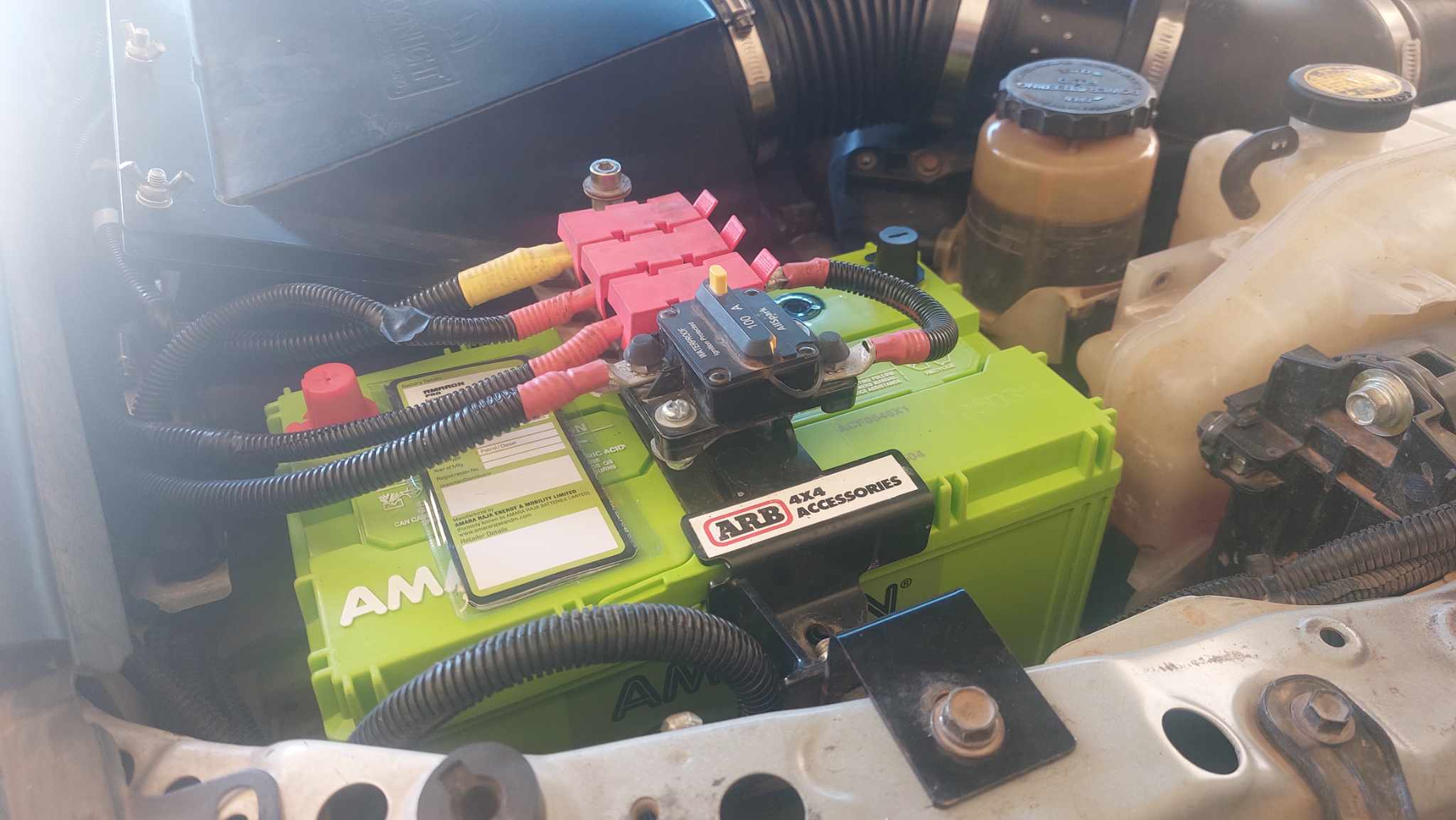Our journey with lithium begun back in 2019; admittedly we were a little late to the party, as companies had been putting forward products that had massive upside to our everchanging ( and often more power hungry ) needs for some years prior.
First and foremost; I am not an expert & I dont claim to be; but I know a little bit about enough on the topic of Lithium now. This is through my own research as well as literally tens of thousands of kilometers of use of Lithium products in our lead tour vehicles & within our camper/ caravan hire business with some trial and error thrown in along the way.
I hope this can give you a bit of an insight into how things have gone for us & some of our thoughts. There is alot of great resources out there for learning about lithium – a quick google search will net you plenty of results.
If you’re anything like me though, the proofs in the pudding. Talk it up all you want all I care about are results.
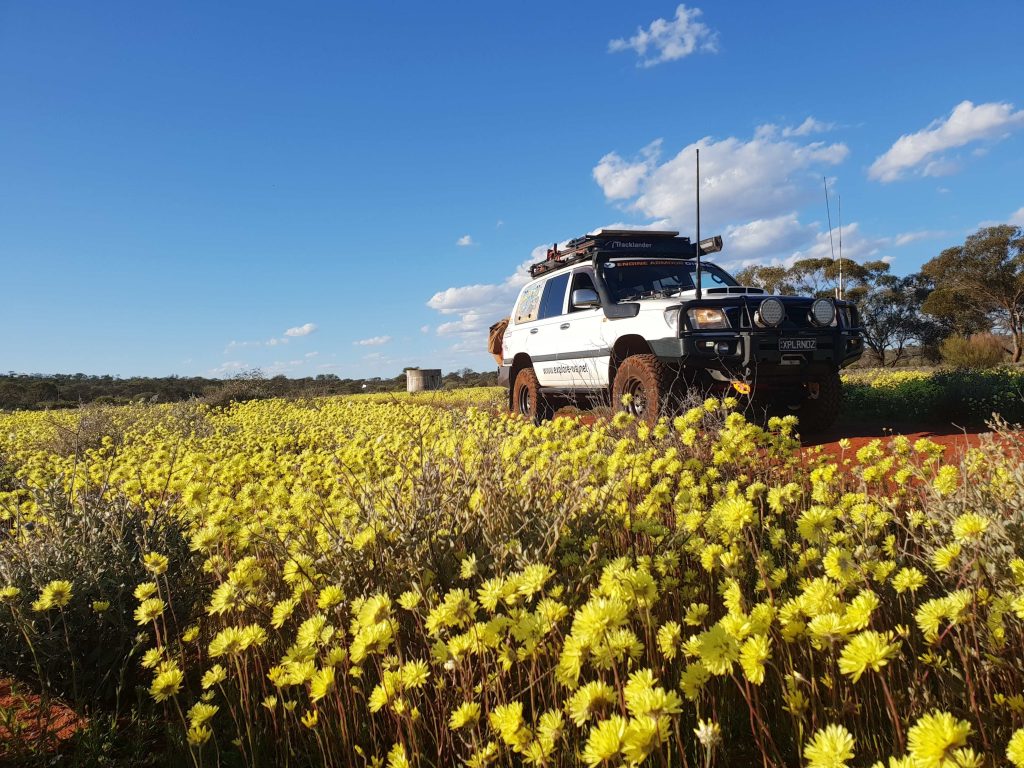
Please check out Aaron's post on Lithium for more info on them!
This is a great look into Lithium that is objective & not biased; something lacking in the world of only blogs and postings. Beware the influenza! Lots of great information contained within this point, so short of replicating it here simply check it out ( opens in new tab )

A bit of background & our early days
Like you, I had heard about lithium, seen plenty of photos and videos of cars going up in flames, and e-scooters catching on fire. So, let’s go and whack one of those things in my 4WD! Sounds like a good plan to me… NOT.
That was my dismissive opinion in the early days, and one of the reasons I resisted moving to lithium. At the time, I used Delkor Calcium wet cell batteries for cranking and winching duties, and these performed well in both our 105 series tour vehicles. Every 2 years, they were changed regardless. One time, I came home from a 12-hour drive from a Pilbara tour to a boiling battery in the driveway that was extremely hot and swollen – I don’t think it was far off letting go and coating the engine bay in acid, to be honest. But this was the only failure I’d had in my 4WD at the time. The deep cycle was in the rear cargo set up, and I was running a Full River AGM battery, widely regarded as one of the better deep cycle AGM batteries of the time – it still is today, I believe. All up, I probably had the best part of 100kg of batteries onboard.
After changing vehicles, I decided the weight factor was a huge consideration in the new build. So XPLRNOZ MK2, our 1HDFTE converted Cruiser, underwent some changes from the previous car to shave off some kilos. A Full River 120-amp hour battery weighs in around 42KG. If memory serves correctly, the replacement Itech of the time weighed in at around 12KG – so it was a huge saving.
Aside from the fact I was able to try this one out for free (a family member purchased it for an under-bonnet install in a farm ute, but it didn’t fit), I figured I had nothing to lose and everything to gain.
Immediately, I noticed just how good it was to be able to utilize a battery that allowed me to draw down to significantly lower levels without any ill effects – this was probably the biggest point, aside from weight saving, that appealed to me about lithium.
(Note – Now that statement isn’t entirely true, as drawing a battery repeatedly to such low levels or State of Charge, even in Lithium form, isn’t going to promote longer life vs. one kept maintained at higher levels.)
Capacity equivalents are often promoted as part of sales material within the battery industry, and it is true – comparatively, you will get a ridiculous amount more out of the same-size battery (AGM Vs Lithium Amp Hours) by the fact you have the ability to draw down on the battery more with a Lithium without doing irreversible damage to the inner workings of a traditional wet-style battery.
The next key point I wish to make here is with regards to battery monitoring. A simple volt gauge doesn’t tell the full story with a Lithium Battery, and at the point in time of my first foray into lithium, I had no idea. The way in which a lithium behaves, very simply put, is that it holds its voltage right until things are almost kaput, and you will see a steep drop-off in voltage until the BMS (Brains of the battery) shut it down to safeguard against over-discharging.
(Note: Among other things, the BMS provides safety to the battery with temperature control, over-voltage shutdown, etc. Read more about the inner workings of a Lithium battery here.)
For this purpose, a device called a shunt connected to a gauge or Bluetooth app from the likes of Victron or Redarc is well worth the investment in your setup if you have the ability to run your negative feeds to it correctly – much simpler said than done for existing setups. (More on this soon.)



XPLRNOZ MK2 FTE105 - Itech
With the 105fte now equipped with an iTech battery, I set out to enjoy the countryside. Everything seemed to be working great until it repeatedly entered safety protection mode. Frustrated, I removed the battery and replaced it with a Lithium battery from a local provider, Offroad Living. The specific battery I chose was from their Allspark range, a 100A/H version. You can view the specs here < ———-
It’s important to note that I have no formal arrangements or business agreements with Offroad Living. I simply appreciate the ability to speak to someone local and receive support. The staff knows me, and it’s convenient for me to head down there for my auto electrical supplies.
Soon after, I discovered that the Redarc BCDC1240D charger didn’t have the orange wire connected for the Lithium profile to activate. This led to some strange issues and continuous faults. Despite iTechworld’s claim that their batteries are drop-in replacements compatible with existing chargers, my experience suggests otherwise. I highly recommend conducting your own research in this regard. Consider yourself warned.
I returned the battery to iTechworld, where they tested it and assured me that everything was okay. At this point, I hadn’t noticed the wiring issue. The staff, in good faith, took the battery back and refunded the purchase price to my family member. I commend them for their understanding; while they likely encounter operator errors frequently, I appreciate their recognition that I had concerns about getting stuck remote without things working.
This one was definitely my mistake, and I commend them for resolving it.

Our Camper Trailers & Lithium
From here it was all guns blazing, the Redarc charger was set up properly, the Allspark Battery worked perfectly & I sold this on after nearly 2.5 years in the vehicle – i never even had to bring it out of its hidey hole built in the draw system & touch it once.
During this phase, we launched a camper hire business, revealing a significant challenge: people struggled with managing battery power. The resultant damage to our AGM batteries proved costly and complicated, making it challenging to recover expenses from customers who neglected proper usage.
To address these issues, we acquired another Allspark 100A/H for the problematic camper, swiftly resolving our battery concerns. Introducing a lithium-compatible Projecta charger transformed the trailer’s performance, ensuring seamless operation. Even if users depleted the batteries to the point of shutdown, we knew the damage would be considerably less than before. With weight savings, increased capacity, and reduced stress, we successfully avoided incurring additional expenses for new batteries due to negligent renters – a definite win.
Our second camper featured a robust 12V AGM setup with a Projecta charger and monitor (Shunt), which we recently sold. Over our four years of ownership, we installed three sets of batteries in this camper, with the last set added about three months before selling (2 x 100A/H AGM). Simply considering this fact illustrates the cost-effectiveness of lithium despite the initial investment in this particular scenario.
These trailers collectively logged approximately 100,000 km of towed travel spanning WA, the NT, and SA, navigating deserts, the Gibb River Road, and more. They underwent thorough trials with minimal attention to battery management from end users.

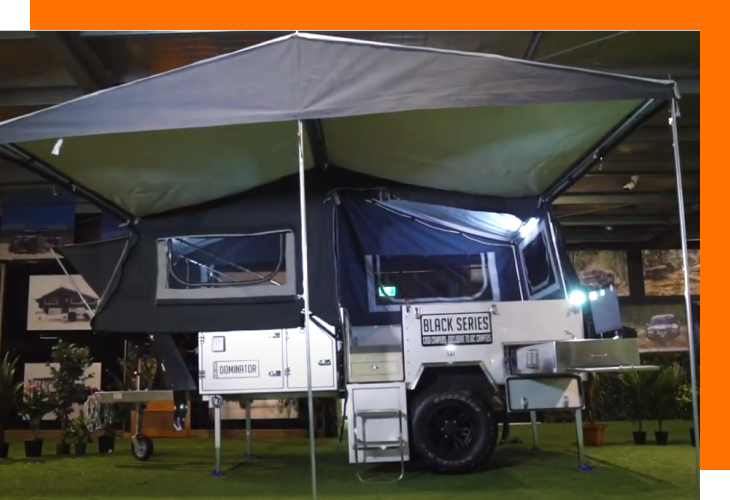

The 200 Seires Lithium Diaries - Allspark & DCS ( Deep Cycle Systems )
Next came the time to fit out yet another tour vehicle as we upgraded to a 200 series. With experience now in the realm of lithium and plenty of firsthand experience with all the benefits, it was pretty easy to overlook the detractions of the LiFePO4 chemistry. Interestingly yet unsurprisingly, these will never show up in the marketing materials. I was probably clouded by just how great I thought things were.
First and foremost, by the time of setting up the 3rd touring vehicle, I’m well-versed in what I need and what I want for long periods on and offroad. I probably should have put it out there that I am *(Was) a very basic camper, and my power needs didn’t extend past a fridge/freezer, lights, a can inverter if I needed it, and that’s about it. I was never EVER anywhere close to testing any of the maximum discharge currents on offer across the ranges of batteries I had used in the past, so I would consider myself a conservative user.
The stumbling block for me was that an extensive vehicle fit-out had already been completed on the 200, and I bought a turn-key tourer basically. It was supplied with a lead-acid crank battery and a deep cycle lead-acid battery under the bonnet, including all electrics terminated up to that end.
In the lead-up to this build, I had been hearing about under bonnet “Rated” lithium batteries. It was a term getting thrown around a lot, and I was very keen to get in on that action with the new car. Save weight and enjoy all the amazing benefits of lithium I have had thus far.
I had heard rumors down at Offroad Living that they were going to be releasing an 80A/H under bonnet crank battery, but it wasn’t yet available. So, I replaced the crank battery with a top-of-the-line Century Marine & 4×4 model. I went about replacing the deep cycle with a DCS (Deep Cycle Systems) that, at the time, had a widely regarded range of lithium batteries rated for under bonnet use with industry-leading specs. These could even be charged directly off the alternator if you wanted (although the new car had a 40amp DCDC REDARC already fitted), so I wanted to continue its use. There were some people grumbling online at this point about lithium not handling heat, with some unhappy customers, but to be honest, the majority seemed pleased, and the lure of all those positives I was accustomed to spurred my decision to purchase from a reseller in Brisbane.
I installed the battery in July 2022 and removed it just a week or so ago.
In that time, there have been very large volumes of customers with documented issues of significant drops in capacity of these batteries under the bonnet. The manufacturer has even amended their terms on tolerances at some point, so really the writing was on the wall. In fact, I was having a great run until last week, until I wasn’t.
Remember, I am a low power “simple” camper. But things got the better of me, and this season I was planning on running a small microwave & induction cooker to help make cooking simpler while I’m running touring adventures across the state. It would also be convenient when I am away with the family. This meant I had to run an inverter. I chose a modest 1500w pure sine model & paired output to consumption of my appliances. I overspec’d the wiring but noticed even with oversize gauge, I was getting crazy volt drop. After rechecking my connections, I measured the terminals at the battery with a 100amp load applied on the DCS and was seeing post voltages drop to 11.6V before tripping the cutoff on the inverter.
I had not noticed an issue before because I would never have been running that kind of amp draw through it. For reference, the DCS 110AH I had is rated for a 200AMP continuous draw.
I am about to follow the warranty process (Wish me luck lol), which involved sending the battery back for “testing” & more than likely waiting for stock. I’ve already resolved the issue because it is rather impractical being batteryless.
After replacing the original crank battery with the Century, it netted me 8 months of service before packing it in, but by this time, I was able to secure the Allspark 80A/H Cranking battery & eagerly fitted it, adjusting wiring terminations, fuse holders, and the like to accommodate the smaller case size.
I had intermittent issues with the battery going into protection mode when cranking over. I would press the start button when the car was warm, and sometimes the battery would just switch off; I wanted to persist as, despite this intermittent inconvenience, it was fantastic, and we were working towards gathering some extra information to provide for fault finding and betterment. When the temperature was hot, the battery replicated this condition more, so I am inclined to say it was related to heat vs load and the BMS interaction within that battery causing a shutdown. We never got any answers on that one in the end, but I know all the batteries they had were retained and are going to be sent back. I removed the battery a week before the DCS at a regular service as it was swollen so it served underbonnet for around 9 months.
Certainly, a swollen battery of any chemistry isnt the kind of thing I want in my engine bay, so I admitted defeat on this one & was forced back to the drawing board. Warranty process with Offroad Living was very straight forward & they refunded me immediately.
So easy being 15 minutes down the road.
I have done some great remote travel with these lithium batteries, corrugations, and offroad touring than most, and I would expect, in the time I have had them, they’ve been thoroughly put to the test in terms of their environment and operating conditions. They’ve endured an Aussie Summer under the bonnet & on one of my remote journeys through the centre of Western Australia I measured with a heat gun, case temps of 76 degrees down to around 72 degrees on the batteries. The highest internal BMS temperature I saw on the app readout for the DCS battery was 76 degrees. This was with an ambient of about 32 degrees.
With the looming 2024 tour season, I was stuck with a lead tour car without batteries, no faith in lithium under the bonnet anymore & wiring that had been set up in the front of the vehicle that meant a more substantial rewire was on the cards to drop a lithium in the rear of the vehicle. This is a pain with a system that has already been set up in a vehicle; due to terminations & feeds run through the car, and the fact this wasn’t a total rewire I couldn’t run a shunt to monitor battery performance & usage – though I am not fussed, to be truthful; knowing your set up inside and out often gives you a quick indication if you notice something isn’t quite right, and I argue, I can still get this from my simple voltage gauge because I know what to look for with my set up; it is, however, not “accurate”.
I did briefly look at Invicta & their Hybrid Battery but at $2400 + per battery, I was not convinced at jumping back into Lithium despite some of their claims – Has anyone even really beat up on the Invictas because through my research, I did’nt really find any conclusive real world information on them. Id love to give one a try – but at that price point, I think I would want to be pretty well certain I’d get my moneys worth first.
So ultimately, with all this laid out in front of me a moving of lithium to the rear is exactly what I did.
I nearly secured one of Offroad Living’s brand new ranges of slimline batteries released at the start of March 2024. but, with my window to the tour season approaching, I had to bite the bullet to get stuck into the install one evening (Missed out on their delivery by 12 hours) and ended up ripping the lithium out of the Camper & fitted it into the rear of the Cruiser. The specs sufficed for all I needed & 100A/H capacity is actually totally fine for my set up. There is always room to go bigger If I need it in the future or the situation changes. This painless exercise took an afternoon, and I had everything terminated, fastened, secured & protected. I made some popcorn in the microwave to celebrate.
At this point I was left with two holes under the bonnet where batteries needed replacing; I ended up taking the recommendation of Aaron Schubert from 4×4’ing Australia & fitted the Indian manufactured Amaron batteries. These bright green lead-acid batteries certainly spice up the engine bay; I’ve redone wiring to suit, switched the 200 back to twin cranking set-ups, and I am now away again.
What a saga – I am, however, able to get the weight watchers’ meals cooked pretty quickly now in the microwave! Win – Win.
In summary here, the writing was probably on the wall regarding the noise people were beginning to make at the start of my lithium journey when I considered under bonnet lithium. I should have listened – the technology & indeed the very chemistry of these batteries don’t make them conducive to being a particularly suitable environment under a hot bonnet in a harsh country like Australia with our extreme temps. The voices have certainly got louder with more awareness of limitations through research & personal experience of the public as time has gone on. Marketing is designed to sell products – thats all I will say. Sometimes we as the consumer must cut through that & really work out what will suit, and what wont.
Once again, do some reading here on lithium & their limitations, as more information is now readily available on the topic. Despite my bad luck, I actually loved everything that Lithium power has afforded me while under the bonnet.
As soon as a bonafide alternative is available – I will happily switch back!
I will keep you posted on how DCS handles my warranty together with VEOP; I am hoping to send it back in the next week or so, I’ve just had it capacity tested locally at my cost & they ran it 3 times and it had 7% of its original capacity. Print out below.





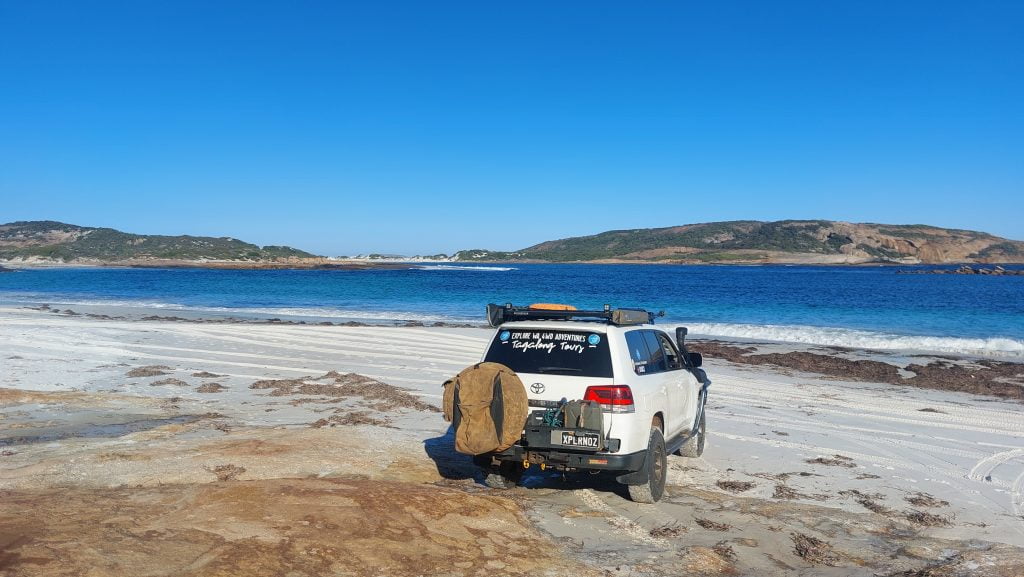
The Amarons have been fitted in the 200. Back to lead acid. Below: Allspark slotted nicely down the back, hidden with the inverter. Terminations, fuse block & junction stud runs on the rear draw system. Photo coming soon


480A/H of Offgrid Lithium in the Caravan
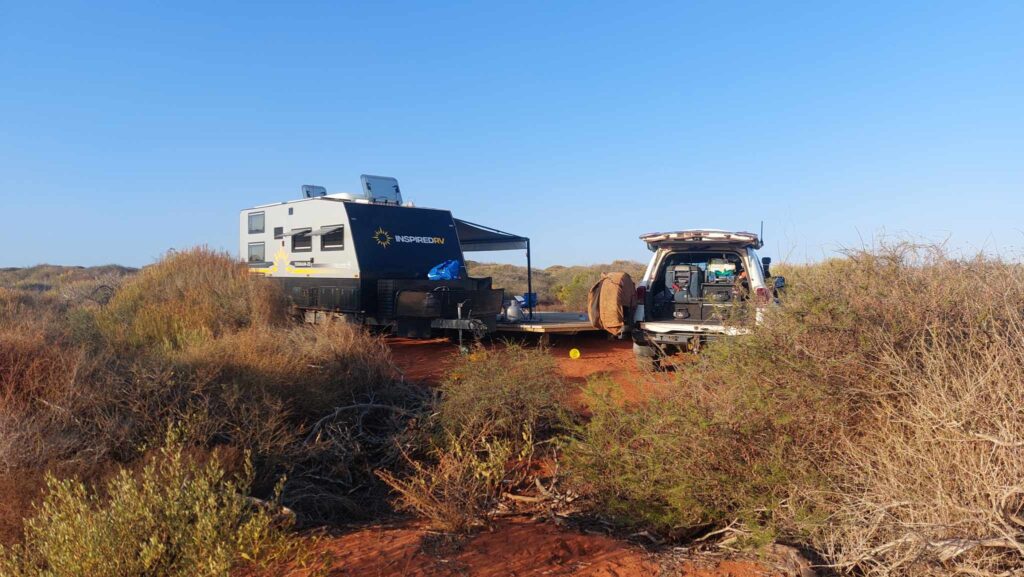
We purchased an off-road caravan for the rental business, which doubles as a wonderful family van. As someone who prefers to steer clear of caravan parks more often than not, I always hoped to get the van off-grid ready with a setup to power 240V appliances, making tasks like microwaving food and preparing bottles for the kids super easy when camping off-grid.
Compounding this is that some of the best campsites are not generator-friendly anyway – so for the ultimate flexibility, we wanted to bite the bullet.
With the looming changes to regulations, things would have been a bit more difficult to enact and not as cost-effective. The new regs, if you would like to read them here, are a modernized and updated set of guidelines that have generally been well-received and make sense to ensure additional safety and control measures at a manufacturing and third-party installation level are done properly.
We received an estimate for north of $13,000, including installation, for a system for our van.
At 15% of the purchase price, it’s a significant investment. We thought long and hard about it and simply couldn’t justify what would have been a 10-year system in a van that will be turned over every 3 to 4 years. I bit the bullet and returned for a complete Itechworld 480A/H Lithium kit, utilizing 2 x 240A/H ItechX Pro batteries, 3000W inverter, 40Amp 240V charger, 40 AMP DcDC charger, Shunt & BM500 battery monitor interface. I purchased this for $5000 on the nose, spent $1000 on consumables, and took a week of evenings to slowly bring about an easy-to-use off-grid system for our van.
It worked absolutely perfectly, and taking the time to chip away, fab up things like wooden frames and holders, carpeting, and neatly running the wiring, fuses & the like was really worth it. It also means I know every in and out of this system. I also added in extras such as fuse blocks, junction studs & other Anderson points, all of which would have been extra charges on top of the quotes we had – I am actually very glad I did it myself now in hindsight.
The pass-through inverter was professionally wired, and we also incorporated a soft start for the air conditioner (Houghton Belaire 3400) to manage its high rotor amps on startup. I highly recommend the Eltwin Hyper Soft start units, which proved to be a game-changer and much nicer to the inverter. Newer air conditioners, like the recently released Dometic range, also offer soft start capability, among other options in the market.
Having the ability to create a system from scratch ensures a known quantity, and the Itechworld kit has lived up to its promises. As a mid-range system, I am eager to test it further over the coming years. So far, it has successfully handled significant trips and performed exactly as expected. We will continue to provide updates on its performance.



Parting thoughts -
More generally speaking on our Lithium journey as a whole, if you are in the situation where you are considering a swap to Lithium as part of your touring set up, consider how you are likely to use your system.
A cheaper Lithium with lower specs i.e ( reduced maximum continuous discharge ratings ) can still be perfectly fine for simple, low draw offroad touring, when your running fridges and lights. You can get some expensive batteries with very impressive specs that will run anything up to air conditioners through massive inverters but do you have a need for that? As i write this, the KINGS 100Amp Hour lithium is available for $350 – thats cheaper than alot of AGM batteries. Is it worth a punt? You can find teardown & capacity test videos online for these & they are very reasonable for the money according to the testings. Longevity? Not sure yet, but no brands perfect by a long shot & that is an honest fact.
Cell type, BMS quality & general assembly are all other factors in choosing a battery – beware there have even been cheap Lithiums found on online marketplaces with concrete & house tiles inside the cases to make up a weight, and a miniscule battery in the centre – Yikes. Promise me you wont go too cheap okay!
Premium brands like Enerdrive have been synonymous for quality gear & the likes of Redarc have followed suit. There are entry, mid range & premium options to suit everyone now.
Some fantastic resources where people with a whole lot more of an idea than me have stripped apart brand named ( and non branded ) lithium batteries and performed capacity tests & general analysis pitting batteries available to the consumer against their claims. It is often a case of a mixed bag of results. These are well worth seeking out online and are a valuable resource and point of discussion.
Facebook has some great 12V & lithium groups if you are on the platform to aid in your research. These can also help with setting up a system yourself & provide a forum to ask questions too.
While this post wasnt full of technical jargon, I hope it explained some of what we have experienced using lithium batteries in our set ups. Lithium has changed our power options to no end & Im really all for it!
The positives really do outweigh the negatives.
Until next time,all the best
Jed Currey
Owner, Explore WA 4wd Adventures



